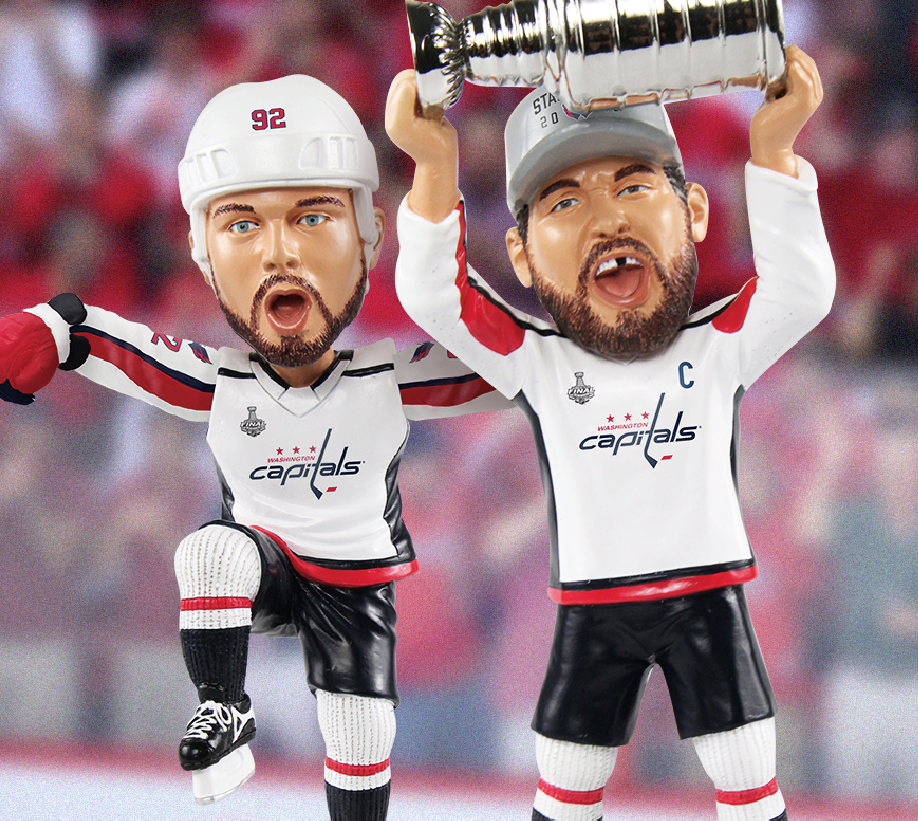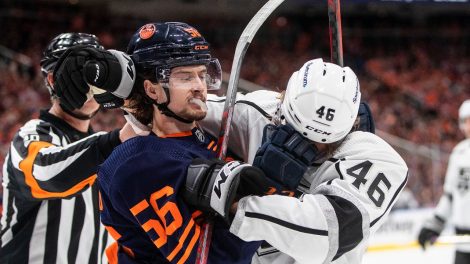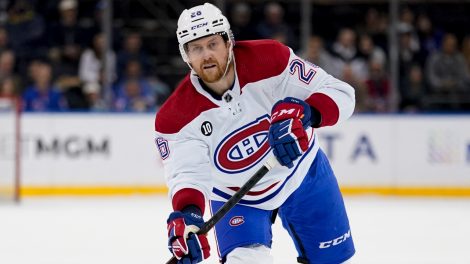A quick mix of things we gleaned from the week of hockey, serious and less so, and rolling four lines deep.
1. Dylan Larkin shared a room with Quinn Hughes this spring in Herning, Denmark, and both University of Michigan studs helped Team USA defeat Canada in the bronze medal game.
When these two bright lights of American hockey reconnected this week at the Power Edge Pro skills camp in Toronto, Larkin took a moment to tell Hughes he supported the 18-year-old defenceman’s decision to return to Michigan for his sophomore year. “Even though he left after one,” Hughes notes.
I asked Larkin what Vancouver is getting in Hughes. You may wish to hold onto something solid, Canucks fans.
“The kind of defenceman I love playing with is a good-skating, puck-moving defenceman — and that’s exactly what they’re getting. He could be a Norris Trophy defenceman with his offensive instincts. He’s a great skater; he can skate around anybody. And he’s a great passer. Maybe a Duncan Keith but a better skater.”
Not too shabby. Keith is only a four-time all-star, three-time Stanley Cup champion, two-time Olympic gold medallist, two-time Norris winner, and a one-time Conn Smythe hoister.
So, Dylan, do you think Hughes is NHL-ready now?
“Seeing him at the world championships,” Larkin says, “he continued to improve every game. His confidence grew. I thought he could play [NHL] for sure. You can never question someone going back to school, especially a school like Michigan, where you could get that degree or get closer to it while playing high-level hockey.
“He’s just going to get stronger, and next year without a doubt, he’ll be in the Canucks lineup by the end of the season.”
Larkin, who signed a five-year deal Friday, is pleased with the Red Wings’ off-season signings of Thomas Vanek, Mike Green, and Jonathan Bernier.
“We’ve got some great depth, we’ve got some great veterans, and there’s going to be some young players who are fresh faces in the lineup who are going to help our team,” he says.
“I’m really confident how our lineup’s looking. If we come together and everyone plays to their capabilities, it’s going to be a great year for us.”
Not unlike Vancouver with Hughes, Detroit believes it got a steal at the draft by scooping up dynamic right wing Filip Zadina.
“Especially as a centreman, that’s someone you want to play with. A skilled guy. You get to watch his highlights. And he was in Detroit for a while, so I skated with him. He’s got great talent, a great kid,” Larkin says.
“I’m really fired up that we got him. I know a lot of Wings fans wanted a steady defenceman, but he was the best player available and he could be a superstar in the NHL, so it’s awesome we got him.”
2. Hughes admits his decision to return to Michigan versus going one-and-done wasn’t an easy.
“It was on my mind pretty much the whole day. I didn’t know what I was doing,” says Hughes, who has been training alongside Canucks veteran Sam Gagner this summer.
“But now that I have a decision, I went into the world juniors [showcase] with a clear thought process. I thought I made a really good choice and was confident in my camp there. For me now, I can just focus on getting stronger, getting bigger and joining the Canucks as soon as possible.”
At the worlds, Hughes’ locker was right next to Team USA captain Patrick Kane’s.
“Congrats on your decision,” Kane texted the kid in late July.
“Nothing crazy, but it was nice of him to reach out,” Hughes says.
“It’s not the path; it’s the player. So if you’re a good player, it’s going to work out for you.”
Hughes’ father, Jim, once served as the Maple Leafs’ director of player development. One imagines him pushing his son to be patient, but Quinn says that wasn’t the case.
“He didn’t pressure me one way or the other. He wanted me to make my own decision here; he thought that was important,” Quinn says. “He supports this, he’s happy with it, and even the Canucks are happy with it too. It’s another year to just get better.”
Quinton’s on his way, and it’s OK! Everything’s OK!
https://www.youtube.com/watch?v=zDoV48DFt3k
3. The 50-some-odd folks escaping a heat wave to hang around a North York rink were treated to some spectacular skills at PEP.
Watching, for example, Connor McDavid, Connor Brown and Scott Laughton face off against Larkin and the Hughes brothers in 3-on-3 mini games confined to a third of the rink gives you fresh appreciation for what these guys can pull of in tight spaces.
“Oh, yeah,” Chicago’s Alex DeBrincat says of Jack Hughes, 2019’s consensus No. 1 pick. “He’s pretty incredible to watch. He reminds me a lot of Connor. It’s definitely fun to watch, seeing him buzz through those cones and stuff.”
Having just endured the draft-year gauntlet, Quinn says he doesn’t need to give much advice to Jack, a 17-year-old who hung right with the pros through drills, his full cage the only giveaway.
“Jack’s a pretty smart kid. I don’t need to tell him anything too earth-shattering,” Quinn says. “He knows there’s going to be pressure, but honestly I don’t think he sees it as pressure. He’s just excited to play hockey.”
The Hughes boys’ on-ice chemistry is undeniable, and they had a blast turning heads in Kamloops.
“We didn’t plan out plays and stuff, but we’re both smart players, so we can find each other. And we train together. I grew up watching him play, so I know what his mind-set is a bit, and I kinda know what he’s thinking sometimes. He’s a smart player, so I like to give him the puck,” says Quinn, but he refuses to jump aboard Team Tank.
“I’m not hoping for that. I’d love to play with Jack, but I’m hoping the Canucks do well this year. I’m not thinking about it too much because I have no control over it.”
Prior to the world juniors showcase, the siblings had played just one real game as teammates, three years ago when Jack played two years up on the Minor Midget Marlies.
“I remember he had a goal. I might’ve walked away with a couple apples,” Quinn recalls. “That was pretty fun.”
You know who else was training at Power Edge Pro? Luke Hughes, age 14.
4. Jack Hughes went bonkers last winter for the U.S. National Team Development Program. His 116 points in his 16-year-old year crushed the previous record held by Kane and Clayton Keller and came within one of the all-time record set by a 17-year-old Auston Matthews in 2015.
“It was cool, of course. It was an honour to hold a record with those guys and break them, but honestly I’m not too worried about those guys. I’m just focused on my game, trying to get better and produce,” Jack says.
The younger Hughes has opted to return to the USNTDP (look out, Matthews) instead of going to college.
“The ability to play with Quinn at Michigan was really tempting. I think the NDP is the best spot for me, so I’m excited to go back. I got a lot of goals in mind,” Jack explains. “I’m just worried about getting my game better each and every day, and I feel NTDP is the best place to do that.”
5. “Anytime you get to be on the ice with players like this, it’s really cool,” Jack Hughes said of the intense 90-minute stick-handling drills at PEP, all of which are conducted at top speed.
McDavid is the posterboy for the mini camp, which improves acceleration, vision, balance, and hand-eye coordination by running players through a series of patented obstacles that mimic game-scenario chaos.
“There’s a lot of guys using it now. I know all the big gyms around the city use it. We use it up at Gary Roberts every now and then. It’s definitely a product that’s taken off, so that’s good to see,” McDavid says.
“It’s just fun to get a group like this together. A lot of guys from around the city, and a couple guys come in for the camp to work on their game.”
Red Wings player development coach Shawn Horcoff brought PEP to Detroit last summer, and Larkin got hooked.
“From my time doing it, I’ve felt like I’m a different skater, and my hands and my feet are moving at the same speed — or close to it — and my eyes are up, so it’s great training,” Larkin says.
“If you get a player on it when he’s 12 years old, it’s gonna help him a ton.”
Columbus’s Boone Jenner first encountered PEP through coach Nick Quinn when they both played for the Oshawa Generals but is just now getting back to it as a pro.
“It’s challenging,” Jenner says after going through the ringer. “It’s something different for me. A new kind of challenge. A lot of hands and feet and quick plays, so it’s been fun.”
6. Contractually, Jenner entered 2017-18 in an interesting spot with the Blue Jackets. In the final season of his entry-level deal, he exploded for 30 goals, but the sides only agreed to a bridge deal in the summer of 2016. His production dropped in each season since, and he was due to turn RFA again this summer.
“It’s definitely different than other years,” Jenner admits. So he was thankful this summer to gain four more years of security and $15 million.
“I’ve been in Columbus for five years now, and to be signed back there again, it’s really exciting,” Jenner says. “The team we have now, the way we’re going, it’s super exciting to be part of. What we’ve built there we want to keep going and take to the next level.”
For two years running, the Jackets have lost to the eventual Stanley Cup champs in Round 1. Jenner knows that hopes of going deeper depend on retaining superstar Artemi Panarin.
The Bread Man, set to wrap his own bridge deal, does not wish to remain in Columbus long-term. His teammates, however, want to go for it now.
“He gives you another dynamic. He’s a game-breaker. When he has the puck on his stick, it’s dangerous. He’s got that ability to take it from one side and go in and score. It’s an element not all players and teams have. He’s a special player and he had a great year for us,” says Jenner, an alternate captain.
“We obviously want to keep him around. We’re just looking forward to camp. We want him to stay. It’s not just him as a player; as a teammate, he’s an awesome guy to have around. Who wouldn’t want to have him around? That’s how we feel.”
7. I am not a fan of the Carolina Hurricanes’ off-season moves.
I am a fan of Teuvo Teravainen’s off-season moves:
8. Aug. 4, 2018: John Gibson will remember that date for the rest of his life. He got married and signed a $51.2-million contract on the same day.
We picture Gibson’s guests sliding envelopes into the box feeling like they’re bringing sand to the beach.
When Gibson’s extension kicks in for 2019-20, his cap hit will rank fifth among all goalies:
1. Carey Price $10.5M
2. Henrik Lundqvist $8.5M
3. Tuukka Rask $7M
3. Marc-Andre Fleury $7M
5. John Gibson $6.4M
Good news for Anaheim: Gibson is at least five years younger than everyone else on that list and 11 years younger than Lundqvist.
More good news for Anaheim: Gibson’s deal is unique in that it is all base salary, no signing bonus. This makes it buyout-friendly but not lockout-friendly.
Some cautionary news for Anaheim: Any long-term deal for a goalie, Price included, makes us worry. Also, the Ducks nearly tripled Gibson’s salary after he went 0-4 with a .889 save percentage in the playoffs.
9. Always fun times co-hosting the Tape to Tape podcast, especially digging into some juicy Canucks off-season storylines with Corey Hirsch (listen below).
On the topic of the Jeff Skinner trade, I’ve been thoroughly impressed by Sabres GM Jason Botterill’s early steps toward improving a horrible hockey team in a fantastic hockey market.
Either top-six centre, Jack Eichel or Casey Mittelstadt, will get a pure finisher on his left, and if Botterill realizes that Skinner doesn’t want to remain a Sabre long-term, well, he can flip him for a first-rounder at the trade deadline. Buy low, sell high.
If Chicago can get a first for Ryan Hartman, surely Buffalo can get a first for Skinner. Every playoff-bound team wants more scoring.
10. If the Hurricanes let 30 clubs know that a 26-year-old, three-time 30-goal scorer is available for trade and they can’t even fetch a first-round pick in return, what does that do for Max Pacioretty’s value?
Pacioretty, a fellow left-winger, is three years older. He scored seven fewer goals and 12 fewer points than Skinner last season. Thus far, we count the P.K. Subban and Mikhail Sergachev trades as losses for Marc Bergevin. Can the GM’s employment survive if he doesn’t fetch a decent return for Pacioretty?
If the captain remains in red come training camp, it might cause a sideshow, but perhaps the only way to up Pacioretty’s value is to have him fly out the gates back to his 35-goal pace. His stock couldn’t be any lower, could it?
One note that didn’t make my recent article on Victor Mete was how appreciative the rookie was of Pacioretty’s leadership.
“He was great,” Mete says. “At 19 years old, it was tough to go and play for an organization and city like that, kinda like Toronto, where the media is everywhere. But the way he brought me in and taught me everything, I thought he was really good.”
11. Are you like me? Do you enjoy a good bobblehead?
Well, the opportunistic folks at FOCO unveiled this beauty: an Evgeny Kuznetsov Flying Bird Celebration bobblehead.
The arms flap. Wonderful.

12. Rest in peace, Stan Mikita. Your unique contributions to the game cannot be overstated and should not be forgotten.
Just imagine if we were still playing with straight blades like a bunch of chumps.
https://twitter.com/Dave_Stubbs/status/1026975893661659137
“Anyone who has met him has only said good words about him. It’s a pretty sad day for the organization,” DeBrincat says. “We’ll keep his family in our thoughts.”








